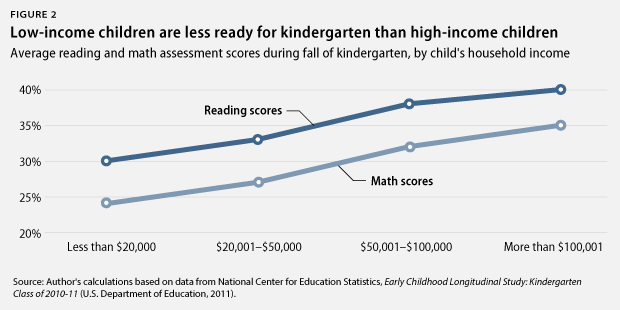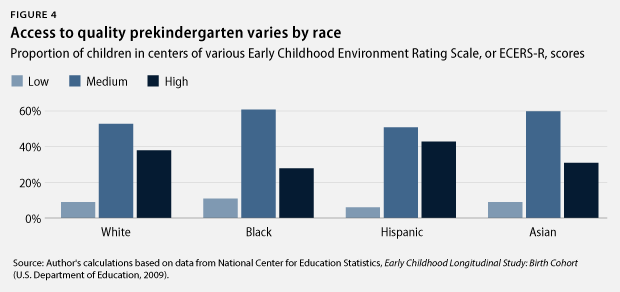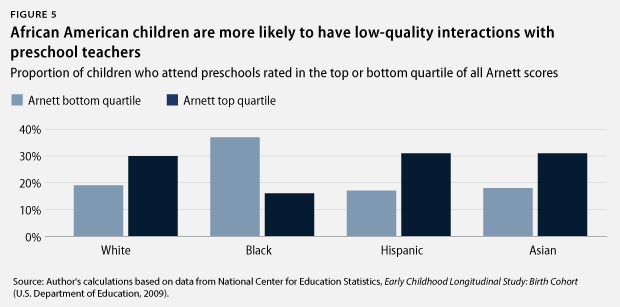The past decade has been significant for the growth of early childhood programs. From the increased understanding of brain development in infants and toddlers to the more rigorous monitoring of social and educational outcomes, the early childhood field continues to move forward. Indeed, recognizing the importance of early education, states and localities have worked to expand opportunities for preschoolers. On a federal level, President Barack Obama is committed to providing all children access to high-quality preschool opportunities. Congress followed suit and made a down payment on early childhood education earlier this year, investing more than $1.4 billion in new funds for 2014. This momentum has compelled states, cities, and philanthropic partners to think about the connection between the future of the United States and how the youngest children are educated. Despite strong progress to date, there is still much more to do to ensure that all children have access to high-quality early childhood programs from birth. The following six charts show why policymakers need to invest in early childhood education now.
Research indicates that access to quality preschool can provide a boost for children that will influence their success for the rest of their lives. Unfortunately, not every child has access to high-quality early education, and many of children who could benefit do not attend preschool. (see Figure 1) This is particularly true for low-income children and children of color.

Without access to quality preschool, low-income children are far less likely to be prepared to start kindergarten than their wealthier peers. (see Figure 2) Moreover, children of color are far more likely to be low income or poor compared with their non-Hispanic white peers. This will have a significant effect on the future of the country since the majority of the current cohort of infants and toddlers are children of color. Of children under the age of 5 living in poverty, 42.5 percent are African Americans and 37.1 percent are Latinos. By 2043, these children will form the base of the country, making up a majority of the population. Ensuring the success of these children is imperative to ensure the success of the country.

High-quality preschool that supports both the cognitive and socio-emotional development of a child is one of the most important tools for reversing some of the effects of economic inequality. A common instrument for measuring quality in prekindergarten settings is the Early Childhood Environment Rating Scale, or ECERS-R, which rates settings on seven categories: space and furnishings, personal care routines, language-reasoning support, teaching activities, child-caregiver interactions, program structure, and parents and staff. However, the majority of children who are in preschool are not in settings that are considered high quality. Furthermore, access to high-quality programs is slightly skewed in favor of higher-income children. (see Figure 3) This means that rather than narrowing the school readiness gap, differences in access to high-quality preschool exacerbate the disparities between wealthy and low- to middle-income kids—disparities that continue to expand as children grow into adolescence. The benefits of quality early education can sometimes mean the difference between graduating from high school or not, which is a benchmark that is inextricably tied to life opportunities and outcomes.

Similarly, access to quality early education varies slightly by race. While most children, regardless of race, attend a moderate-quality preschool setting, African American children are the most likely to be in low-quality settings and the least likely to be in high-quality settings. (see Figure 4)

While there are several different indicators of quality in early education, including teacher ratings and environmental rating scales, the nature of teacher-child interactions and the quality of instruction are the most predictive of positive child outcomes. The Arnett Caregiver Interaction Scale measures the quality of caregiver’s interactions with children in pre-K settings by observing and rating aspects of a caregiver’s teaching style such as emotional tone, discipline style, and responsiveness or detachment to students in the classroom. When children are exposed to high-quality interactions, research has shown that they are more likely to be successful later in their academic career. An analysis of access to quality as measured by the Arnett scale further describes disparities in access to positive caregiver interactions. Specifically, African American children are much less likely than children of other races to be in programs that score highest on caregiver sensitivity and are much more likely to be in programs that score the lowest. (see Figure 5)

Similarly, children from higher-income backgrounds are more likely to be in preschool settings where they receive high-quality interaction with their teachers than their lower-income peers. (see Figure 6) This exacerbates the school readiness gap in kindergarten and the achievement gap later in life.

The longer policymakers wait to invest in American children, the less likely it is that they will achieve their full potential. Research shows that high-quality preschool creates one of the biggest returns on investment. Given the importance of early learning, making sure that all children are afforded the opportunity to access high-quality early childhood education is a no-brainer.
Rachel Herzfeldt-Kamprath is a Policy Analyst for the Early Childhood Policy team at the Center for American Progress. Maryam Adamu is a Research Assistant at the Center.